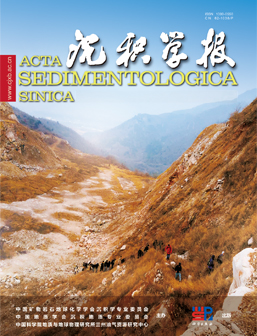Petrological and Mineralogical Characteristics of Barite Nodules in the Lower part of the Ediacaran Doushantuo Formation, Yichang, Hubei Province
doi: 10.14027/j.issn.1000-0550.2024.035
- Received Date: 2024-01-13
- Available Online: 2024-04-30
-
Key words:
- Yangtze block /
- Ediacaran /
- Doushantuo Formation /
- barite nodules
Abstract: [Objective] The redox states of the early Ediacaran ocean has always been a research hotspot. The formation process of sedimentary barite nodules is studied to explore the redox variation of the Ediacaran ocean immediately after the Snowball Earth event. [Methods] Analysis on sedimentary environments of barite nodules from calcareous mudstone of the lower Doushantuo Formation in Jinguadun section were developed via sedimentologic and petromineralogical methods. [Result and Discussion] Sedimentary beddings of the surrounding rocks are curved around the barite nodules, indicating that these nodules are probably classified to diagenetic nodules and formed in sedimentary soft muds during the early diagenetic stage. The barite, quartz and pyrite are the three top authigenic sedimentary minerals in the nodules. The mineral distribution is stratified in the barite nodules. Specially, the inner layer contains dense pyrite aggregates dominated by euhedral to subhedral pyrite grains and quartz minerals that grow interwoven together. From the core to the outer edge developed radial aggregates by barite and quartz. This study preliminarily demonstrates that the formation of authigenic sedimentary minerals occurring in different parts of the barite nodules probably precipitate in different redox zones. That is to say, the pyrite and quartz minerals in the inner nodule are formed in the sulfate reduction zone, then the formation location of nodules gradually transits from sulfate reduction zone to sulfate-methane transition zone. The Ba2+ sources in the barite probably originate from the methanogenic zone, where dissolution of labile and biogenic barite associated with organic matter occurs. The upward spreading Ba2+ ions react with downward diffusing seawater sulfate radicals and deposit barium sulfate in the upper front of sulfate-methane transition zone. [Conclusion] The formation process of the barite nodules is staged. Observation on barite nodules indicates that the depth of oceanic sulfate reduction chemocline has descende into the loose sediments beneath the interface of sediment and water body after the Snowball Event at about 600 Ma, due to the increase levels of the continental sulfate input at that time. Methane was partly oxidized in sulfate-methane transition zone, thus reducing the atmospheric emission of marine methane.
| Citation: | Petrological and Mineralogical Characteristics of Barite Nodules in the Lower part of the Ediacaran Doushantuo Formation, Yichang, Hubei Province[J]. Acta Sedimentologica Sinica. doi: 10.14027/j.issn.1000-0550.2024.035 |






 DownLoad:
DownLoad: